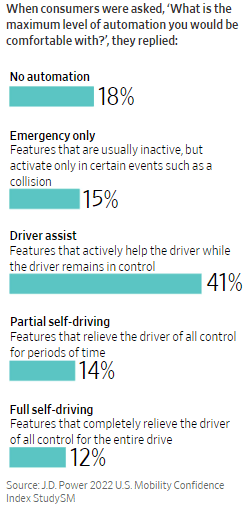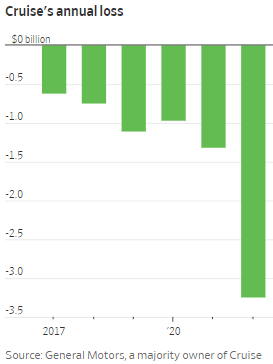Alphabet’s Waymo and General Motors’ Cruise are struggling to win over San Francisco residents and officials, a major hurdle in their nationwide expansion
By Meghan Bobrowsky and Miles Kruppa
SAN FRANCISCO—This city’s inhabitants embraced computers, the Internet and cellphones before the rest of the world caught on. They are not so sure about self-driving cars.
Suddenly, orange and white driverless Cruise and Waymo cars seem to be everywhere. Some first responders say they get in the way, and pedestrians fill social media with reports of the cars’ antics. They have collided with at least two pets. An anti-car activist group placed orange traffic cones on the hoods of the vehicles, freezing them in place while creating viral videos of the stunt.
San Francisco’s reaction is a preview of the challenges Cruise, majority owned by General Motors, and Waymo, part of Google parent Alphabet GOOG , will face as they expand to cities across the U.S. Both companies have invested billions in driverless cars, hoping they will become massive businesses, and they still need to win hearts and minds.
A city of about 800,000 people, San Francisco has already played host to thousands of self-driving car test miles, and some residents are regular users. Now the companies want to offer ride-hailing businesses that can compete with Lyft and Uber.
If the companies get their wishes, San Francisco will become ground zero for one of the first big urban experiments in transportation using autonomous vehicles. The city, now known for its tech population, has also been a hub for political protest, flower children and fierce guardians of the city’s character.
The California Public Utilities Commission, which regulates passenger transportation, is scheduled to vote this month on whether to allow GM’s Cruise to expand its presence in San Francisco and to allow it and Alphabet’s Waymo to charge for rides at all times. The vote has been delayed twice, and the agency will hold a hearing next week to hear responses from the companies to a list of safety concerns.
“We think that autonomous vehicles are amazing and we believe that someday they will be safer than human drivers,” said Jeffrey Tumlin, director of transportation for San Francisco’s transit authority. “So far, the industry has not demonstrated that.”
Cruise and Waymo are fighting back. Executives at both companies have begun presenting their pitches to the public and government officials with greater urgency, armed with data they say shows the safety benefits of their vehicles.
Cruise Chief Executive Kyle Vogt said in an interview that officials would cause more people to be harmed if they slowed the rollout of self-driving cars, citing company data that linked their increased presence to reduced collisions. Cruise has quintupled the number of cars it has on San Francisco roads since the beginning of the year, Vogt said. Most of its almost 400 vehicles nationwide are in the tech hub.
“Anything new, especially a technology that comes across as borderline magic, is going to have a lot of questions and create a lot of attention,” Vogt said. “Attention draws controversy.”
Waymo asked riders to write letters to state officials last month. The company might not be able to continue operating in San Francisco, it said, if the state voted “no.”
Cruise took out full-page ads in several newspapers stating, “Humans are terrible drivers,” citing nearly 43,000 crash fatalities from car accidents in the U.S. last year.
For now, Cruise is offering paid rides at night in San Francisco. Waymo doesn’t have the state’s permission to offer paid rides yet, but people can ride in its cars free of charge. Both have waiting lists to get on the apps.
The group behind the traffic cones, Safe Street Rebel, coordinated the stunt as a weeklong protest of Cruise and Waymo’s expansion ahead of the state commission vote. Members trolled the streets wearing gloves and facial coverings, searching for cars in areas where they are frequently spotted such as the streets around the Panhandle park. The cones confused the cars sensors, some of which are placed on their roofs, stopping them in place.
After the state commission moved back its vote, the activists claimed partial credit for the delay and applauded state officials for applying more scrutiny to the expansion plans.
Cruise and Waymo have burned through billions of dollars in their attempts to build on-demand taxi services, which they hope will eventually produce greater profits without the need for human drivers. So far, their businesses have produced minimal revenue.
GM reported $102 million of sales and $3.3 billion of costs and expenses related to Cruise last year. Chief Executive Mary Barra said in June the company was at the very early stages of a shift to autonomous vehicles, and executives have said the company is targeting as much as $50 billion in annual revenue by the end of the decade.
Waymo has raised more than $5.7 billion in announced funding from Alphabet and outside investors since 2020. Alphabet, which has come under shareholder pressure to reduce spending on Waymo and other speculative ventures, doesn’t separately report on its financial performance.
Amazon.com’s Zoox has also tested its self-driving technology on the streets of San Francisco and is developing a custom, boxy vehicle specially designed for taxi services. The company declined to say when it would begin deploying the cars in the city.
Cruise and Waymo executives condemned the Safe Street Rebel activists who put cones on their cars and uploaded the videos to TikTok. Waymo said it was a form of vandalism. The group later removed the videos.
“This is a moving, multi-ton vehicle. It is not a toy,” Tekedra Mawakana, Waymo’s co-chief executive, said in an interview. The company plans to engage the authorities for help when its cars are vandalized, she added.
Vogt said he didn’t think it was the time to be “playing silly games.”
Safe Street Rebel said the group wasn’t damaging property with the protest. The activists view the cars as a threat to other ways of getting around the city such as walking, biking and public transit, it said.
Beyond San Francisco, there are hundreds of self-driving cars in Phoenix, with more being deployed for testing in Los Angeles, Miami, Dallas, Austin, Texas and Nashville, Tenn. Three years ago, there were only test vehicles in a handful of cities.
Cruise applied in March for permission from the California Department of Motor Vehicles to expand statewide and operate its cars at speeds of up to 55 miles an hour.
Since then, Cruise has sent emails to officials in at least 14 California cities and counties as small as 12,200-person Newman in the remote San Joaquin Valley, informing them of the company’s plans to expand there, according to documents filed with the state’s motor vehicles department. The company said it would begin with five vehicles in each of these new markets, according to one of the emails.
A Cruise spokesman said it notified the officials as part of its statewide application and ultimately wants to operate everywhere in California, but plans to roll out its vehicles in major cities first.
Waymo began offering driverless rides in Los Angeles in February, and this week it announced plans to offer the ride-hailing service in Austin.
In May, San Francisco city officials sent a letter to the state expressing concerns about the proposed expansion in the city. They listed incidents in which a Waymo drove into a construction site, nearly rolling into an open trench, and a firefighter needed to break a Cruise’s window to stop it from driving into an active fire scene.
City officials said the number of reported incidents involving Cruise and Waymo vehicles has tripled in recent months. Tumlin, the transportation director, said officials need more publicly available data from the self-driving car companies to draw conclusions about their safety, and the city is making progress toward that goal.
Cruise and Waymo both said their cars haven’t caused any traffic fatalities. In their first million miles driven, Waymo said its self-driving vehicles in fully autonomous mode didn’t cause any collisions with human drivers.
A Cruise spokesman said it just takes one ride to convert a skeptic to a believer. About 90% of people who have taken a ride are willing to ride in one a second time, he said, citing internal data.
Sebastian Thrun, who previously led the Google Self-Driving Car Project that is now known as Waymo, said people would start to see the benefits if the cars were allowed to operate more widely. When he ran the project, all it took was seven to eight minutes in the car for people to relax and become more comfortable with the technology, he said.
Janie Richardson, a retired deputy city attorney, was crossing the street in the early evening in June with her two dogs in the Pacific Heights neighborhood of San Francisco when she said a self-driving Cruise vehicle entered the intersection and hit one of her black labs, Delilah.
A Cruise technician arrived on the scene about 10 minutes later, she said, and handed her a piece of paper titled “Handout for Others Involved in an Incident with Cruise.” Among other details, it listed insurance information for the car, according to a copy of the letter reviewed by The Wall Street Journal.
Delilah wasn’t injured, but Richardson, who said she previously hadn’t given the self-driving cars much thought, now wants them out of San Francisco. A Cruise spokesman declined to comment on the specific case.
Vogt criticized the city for promoting what he called misleading data. Cruise has spoken with city officials more than 50 times over the past year to hear their concerns and has made changes to the service based on the feedback, he said.
Waymo-Co-CEO Mawakana pushed back on the idea that residents are opposed to the vehicles, citing the 100,000-plus people who have signed up for the waiting list to access Waymo’s taxi service.
“I have people pinging, emailing and complaining every day about how long they’ve been waiting to get into the service,” Mawakana said.
Maya Waldman, who works in education, signed up to be an unpaid test rider for Waymo during an earlier stage in San Francisco and has ridden more than 5,000 miles in the cars.
Waldman, who said she didn’t know much about self-driving cars before the program, now feels safer in them than in traditional ride-hailing services. Among other things, she’s not at the mercy of a random assortment of human drivers.
“Every time I hail a Waymo, it’s the same driver,” she said. “When I get into a Lyft or Uber, which I do still use sometimes, I never know what I’m going to get.”





